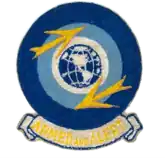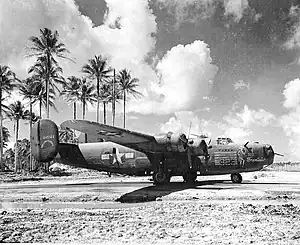372nd Bombardment Squadron
The 372nd Bombardment Squadron is an inactive United States Air Force unit. Its last assignment was with the 307th Bombardment Wing at Lincoln Air Force Base, Nebraska, where it was inactivated on 25 March 1965.
| 372nd Bombardment Squadron | |
|---|---|
 B-47 Stratojets on the ramp at Lincoln AFB in 1960 | |
| Active | 1942–1945; 1946–1965 |
| Country | |
| Branch | |
| Role | Bombardment |
| Motto(s) | Armed and Alert (1959-1965) |
| Engagements | Southwest Pacific Theater Korean War[1] |
| Decorations | Distinguished Unit Citation Philippine Presidential Unit Citation Republic of Korea Presidential Unit Citation[1] |
| Insignia | |
| 372nd Bombardment Squadron emblem[note 1][1] |  |
| 372nd Bomb Squadron emblem[note 2][2] |  |
History
World War II

Formed as a heavy bombardment squadron in January 1942, trained in the Pacific Northwest under Second Air Force, with Boeing B-17 Flying Fortresses. Reassigned to Seventh Air Force in Hawaii, November 1942 and performed performing search and rescue and antisubmarine patrols until January 1943 while transitioning to long-range Consolidated B-24 Liberator heavy bombers.
Deployed to the Central Pacific from Hawaii throughout 1943 for long-range combat bombardment operations against Japanese forces in the Central Pacific; New Guinea; Northern Solomon Islands and Eastern Mandates campaigns. Deployed to the New Hebrides in Melanesia and operated from numerous temporary jungle airfields, engaging in long-range bombardment operations during the Bismarck Archipelago; Western Pacific; Leyte; Luzon and Southern Philippines campaigns until the end of the war in August 1945. Moved to Clark Field, Philippines after the war ended, demobilized with personnel returning to the United States, unit inactivated as paper unit in January 1946 in California.
Strategic Air Command
Reactivated as Boeing B-29 Superfortress squadron at MacDill Field, Floridan August 1946 as part of Strategic Air Command. Was a training unit for antisubmarine warfare. Deployed to Okinawa during Korean War, carrying out combat operations over Korea throughout the conflict. Remained in Okinawa until November 1954 when it moved on paper to Lincoln Air Force Base, Nebraska, as a Boeing B-47 Stratojet medium jet bomber squadron, performed Operation Reflex deployments to North Africa until phaseout of B-47 in 1965 and inactivated.
Lineage
- Constituted as the 372nd Bombardment Squadron (Heavy) on 28 January 1942
- Activated on 15 April 1942
- Redesignated 372nd Bombardment Squadron, Heavy on 20 August 1943
- Inactivated on 26 December 1945
- Redesignated 372nd Bombardment Squadron, Very Heavy on 15 July 1946
- Activated on 4 August 1946
- Redesignated 372nd Bombardment Squadron, Medium on 28 May 1948[3]
- Inactivated on 25 March 1965
Assignments
- 307th Bombardment Group, 15 April 1942 – 26 December 1945
- 307th Bombardment Group, 4 August 1946 (attached to 307th Bombardment Wing after 10 February 1951)[4]
- 307th Bombardment Wing, 16 June 1952 – 25 March 1965[5]
Stations
|
|
Aircraft
- Boeing B-17 Flying Fortress, 1942
- Consolidated B-24 Liberator, 1942–1945
- Boeing B-29 Superfortress, 1946–1954
- Boeing B-47 Stratojet, 1955–1965[3]
References
Notes
- Explanatory notes
- Approved 6 May 1959.
- Approved 16 October 1942. Watkins, pp. 88-89
- Citations
- Maurer, Combat Squadrons, pp. 460-461
- Hubbard, p. 715
- Lineage information through May 1963 in Maurer, Combat Squadrons, pp. 460-461.
- Ravenstein, pp.153-156
- Assignment information through May 1963 in Maurer, Combat Squadrons, pp. 460-461, except as noted.
Bibliography
![]() This article incorporates public domain material from the Air Force Historical Research Agency.
This article incorporates public domain material from the Air Force Historical Research Agency.
- Hubbard, Gerard (1943). "Aircraft Insignia, Spirit of Youth". The National Geographic Magazine. National Geographic Society. LXXXIII (6): 718–722. Retrieved 1 September 2017. (subscription required for web access)
- Maurer, Maurer, ed. (1983) [1961]. Air Force Combat Units of World War II (PDF) (reprint ed.). Washington, DC: Office of Air Force History. ISBN 0-912799-02-1. LCCN 61060979. Retrieved 17 December 2016.
- Maurer, Maurer, ed. (1982) [1969]. Combat Squadrons of the Air Force, World War II (PDF) (reprint ed.). Washington, DC: Office of Air Force History. ISBN 0-405-12194-6. LCCN 70605402. OCLC 72556. Retrieved 17 December 2016.
- Ravenstein, Charles A. (1984). Air Force Combat Wings, Lineage & Honors Histories 1947-1977 (PDF). Washington, DC: Office of Air Force History. ISBN 0-912799-12-9. Retrieved 17 December 2016.
- Watkins, Robert A. (2013). Insignia and Aircraft Markings of the U.S. Army Air Force In World War II. Vol. V, Pacific Theater of Operations. Atglen,PA: Shiffer Publishing, Ltd. ISBN 978-0-7643-4346-9.